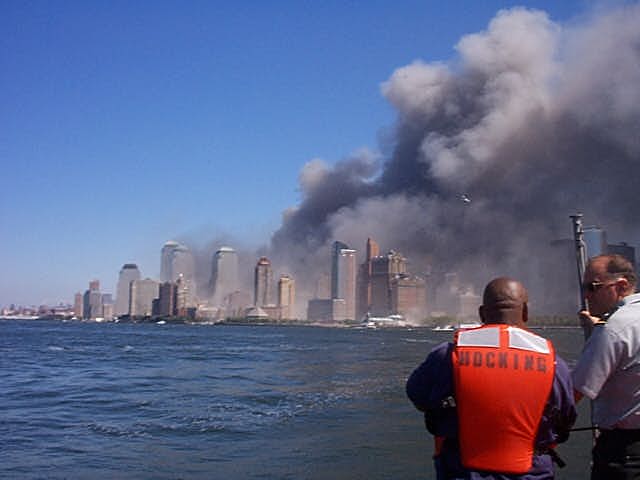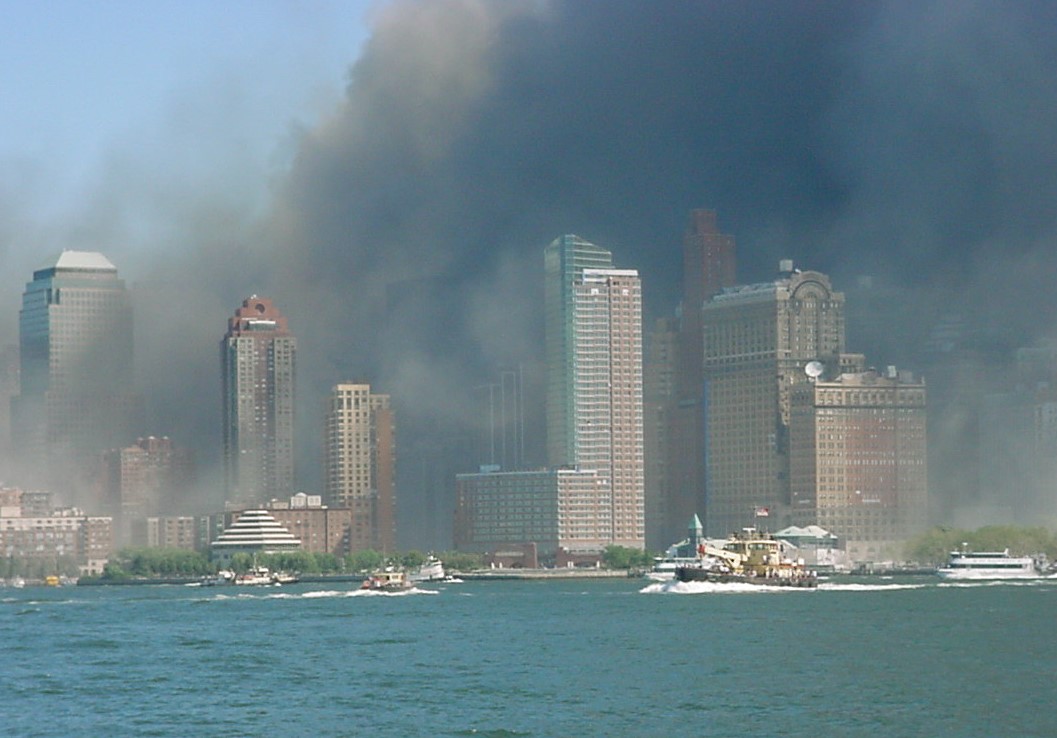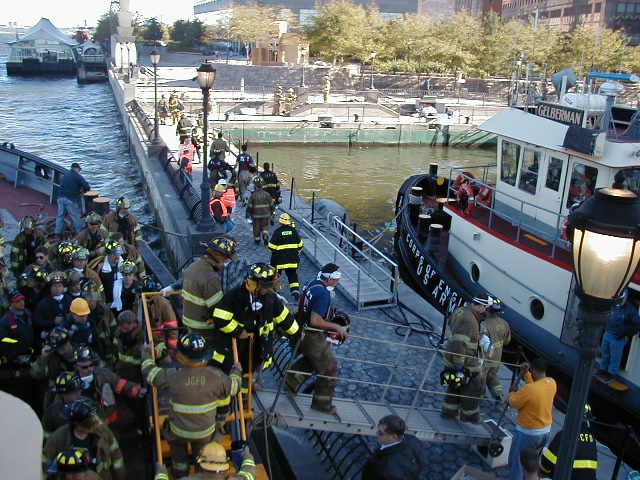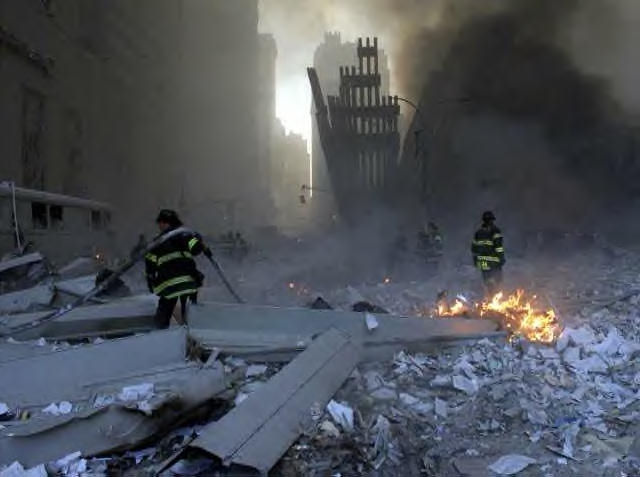I. Initial Attacks and the New York District
| |
 |
| |
The Corps of Engineers patrol boat Hocking heads toward lower Manhattan after the September 11 attacks, with North Atlantic Division Commander Brig. Gen. Stephen Rhoades on board at right. Office of History,
|
On the morning of September 11, 2001, employees of the New York District of the U.S. Army Corps of Engineers (USACE) were at or on their way to their offices at Federal Plaza in Lower Manhattan when the terrorists struck the World Trade Center North Tower just blocks away. Joe Seebode, the district’s chief of the harbor program, was commuting to work on the PATH train and just about to exit the underground World Trade Center station when the first plane crashed. He noted later: “You clearly knew something had happened. You could feel the vibration of the explosion. But I knew it was behind me. I could tell it was not in front of me, and at that point there was a lot of people screaming, yelling. Everybody was running. And I looked to my normal exit , and I could see daylight, and I just ran out that door.”
For those already in the office, no one knew if additional attacks were imminent, and any federal building might have been a target. The swirling dust and debris from the collapse of the Twin Towers made the area around the district offices hazardous. Amid the initial shock and confusion, District Engineer Col. John O’Dowd prioritized evacuating the office and getting the district staff to safety. Transportation and communication were extremely difficult or absent in the hours after the attack, with roads and tunnels closed to traffic and phone lines disabled. Some district staff had to exit Manhattan on foot, walking over the Brooklyn Bridge, taking hours to get home. However, within a day the district was able to account for every staff member as safe and uninjured.
The commander of the North Atlantic Division, Brig. Gen. Stephen Rhoades, arrived in Lower Manhattan by boat at midday September 11. He described the scene near the devastated World Trade Center complex this way: “I went ashore and ash was eight or nine inches deep. Papers were all over the place from offices. You … can imagine the paperwork that just came out of the World Trade Center.… The air quality is terrible. I mean, the dust is in the air. Smoke is in the air…. [T]he biggest thing I noticed was this real light-grade dust, pulverized dust on the ground that was eight or nine inches deep. It comes over your shoe and into your shoe. It was that deep.” That night Col. O’Dowd made his way to what remained of the World Trade Center. What he saw left an impression on the New Jersey native. “There are not words,” O’Dowd said. ”There are not pictures. Nothing you saw on television comes close to describing what that night of the 11th, what it looked like there, what it looked like for weeks after that, and what it did to this whole part of the city."
 |
 |
The view from New York Harbor on September 11, 2001, as seen by USACE
floating plant crew. The two vessels visible ahead are the Corps
tug Gelberman (left) and drift collection vessel Hayward (right). Office of History, |
Firefighters and emergency responders ferried by Corps of Engineers vessels
disembark at the North Cove Yacht Harbor in Lower Manhattan. Office of History,
|
With its staff dispersed over three temporary offices, with no access to files and records, and hampered by communication difficulties, the New York District had limited means to manage any sort of emergency response. Therefore, the North Atlantic Division designated it a victim district, in accordance with USACE procedure, and assigned the emergency response mission to the neighboring New England District, with the Philadelphia District and the division in support. Instead, the New York District would focus on its day-to-day work of awarding and executing contracts and closing out the fiscal year ending on September 30.
Though relieved of the primary responsibility for managing the USACE disaster response, the New York District did participate in the effort. The district staff played valuable liaison and coordination roles with city and state leaders and the Federal Emergency Management Agency. As New Yorkers themselves, they understood the unique culture of the nation’s largest city and its desire to lead the recovery effort. The district’s floating plant continued to transport people and supplies. The staff issued emergency dredging permits within a day for legal dredging in several locations (which was then accomplished within a week) to allow barges to remove debris and to expand ferry services. Finally, local New York District personnel and deployed Corps experts aided rescue and recovery efforts with Geographic Information System support, creating computerized maps of Manhattan and the World Trade Center to pinpoint underground fires and other hazards to the rescue workers. The district staff also helped manage and stage supplies.
 |
|
The nightmarish landscape around the World Trade Center complex
shortly after the fall of the towers. Office of History.
|
After three weeks of difficult work, including salvaging computers and files from their offices, Col. O’Dowd and his staff reconstituted the New York District. Simultaneously they completed work on millions of dollars’ worth of contracts by the end of September. Brig. Gen. Stephen Rhoades, commander of the North Atlantic Division, described the effort as “probably New York’s finest hour.” In October the district assumed responsibility for the largest USACE-led aspect of the recovery—managing the removal of 1.2 million tons of debris from Manhattan to the Staten Island landfill for inspection and processing. Col. O’Dowd acknowledged the district’s efforts in the midst of tragedy when he wrote in fall 2001: “I will always be proud to say that at this time and place ‘I served with the New York District of the United States Corps of Engineers.’”
September 2021. No. 144.
Office of History's series of articles remembering the responses to the attacks of September 11, 2001